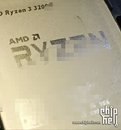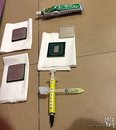Monday, April 22nd 2019

AMD Ryzen 3 3200G Pictured and De-lidded
AMD Ryzen 3 3200G is an upcoming processor featuring integrated graphics, forming the tail-end of the company's 3rd generation Ryzen desktop processor family. A Chinese PC enthusiast with access to an early sample pictured and de-lidded the processor. We know from older posts that while the "Matisse" MCM will form the bulk of AMD's 3rd gen Ryzen lineup, with core counts ranging all the way from 6 to 12, and possibly 16 later, the APU lineup is rumored to be based on older "Zen+" architecture.
The Ryzen 3 3200G and possibly the Ryzen 5 3400G, will be based on a derivative of the "Raven Ridge" silicon built on the 12 nm process at GlobalFoundries, and comes with a handful innovations AMD introduced with "Pinnacle Ridge," such as an improved Precision Boost algorithm and faster on-die caches. The 12 nm shrink also allows AMD to dial up CPU and iGPU engine clock speeds, and improve DDR4 memory support to work with higher DRAM clock speeds. AMD has used thermal paste as the sub-IHS interface material instead of solder for its "Raven Ridge" chips, and the story repeats with the 3200G.
Sources:
ChipHell Forums, ComputerBase.de
The Ryzen 3 3200G and possibly the Ryzen 5 3400G, will be based on a derivative of the "Raven Ridge" silicon built on the 12 nm process at GlobalFoundries, and comes with a handful innovations AMD introduced with "Pinnacle Ridge," such as an improved Precision Boost algorithm and faster on-die caches. The 12 nm shrink also allows AMD to dial up CPU and iGPU engine clock speeds, and improve DDR4 memory support to work with higher DRAM clock speeds. AMD has used thermal paste as the sub-IHS interface material instead of solder for its "Raven Ridge" chips, and the story repeats with the 3200G.


49 Comments on AMD Ryzen 3 3200G Pictured and De-lidded
so this is 3000 but 12nm ?
a chiplet"Raven Ridge" refabbed on 12 nm with a sprinkle of "Zen+" fairy dust. My hopes for integrated Navi15/Navi20 may soon come true. :roll:Potato-potato. It's still goinig to be awesome.
The question on people's mind right now must be "when we will get Zen2 based APUs"
3000-series APU, just like mobile SoCs, are Zen+. Mobile parts are already here.
3000-series APU, technologically similar to Ryzen 2000-series, will be out in May (these are the chips that latest motherboard BIOS updates are meant for).
3000-series Ryzen (Zen2, 7nm) is expected later this year.
EPYC side is still a mystery. At this point it's still all Zen, with just 2 CPUs announced after the initial batch.
IMO they may launch Zen2 EPYC before Ryzen. Intel's offense with MCM and Optane will eat them alive otherwise.I'm reading another thread with senior members, staff and AMD supporters struggling to get their heads around AMD's naming and lineup.
Just open a comprehensive source and learn it.
wikichip.org is not a bad place to start.
@W1zzard
Maybe you could be a good lad and write a Zen guide?
People on this forum have been confusing Zen2 and Ryzen2 for a year, but now there's a good chance AMD will be making 3 generations of CPUs (EPYC, Ryzen, APU), on 3 generations of Zen at the same time - all mixed up.
If AMD launches these with Ryzen 3000-series (July?) - great. Vega 8-11 taken straight from previous gen will be more than enough.
If they wait another year to launch these with Navi, then it's just a year of lost sales in a very profitable segment (business desktops).
Unless AMD decided that they aren't going to win a significant market share anyway, so these APUs will be 100% gaming-oriented - in which case you're right with DDR5.
It's exactly the same on the mobile front. It's been a year since Intel started selling 6-core SoCs (8C around the corner). AMD is still stuck at 4...
AMD is like a box of chocolates...
3000-series mobile SoCs were announced in January. It's basically the same chip as 2000-series (same Vega as well). They simply increased the clocks by around 5%.Of course people will look at 3000-series Ryzen (Zen2) reviews and buy 3000-series APUs (Zen+). That's how marketing works.
It's by no means better or worse than what Intel and Nvidia have been doing.
The only interesting part is how AMD-supporters will react, because they used to be very vocal about AMD's competitors' practices. :-)
Well that's true because APU also take more time, AMD's GPU develop asynchronously with their CPU so depending on when Navi was completed they'd get an APU anywhere between 6~12 months from the day their latest core uarch (zen2) was finalized.
can we not just say "from now on every IHS is quality soldered on and thats that, thats just the way cpus are put together, end of story".